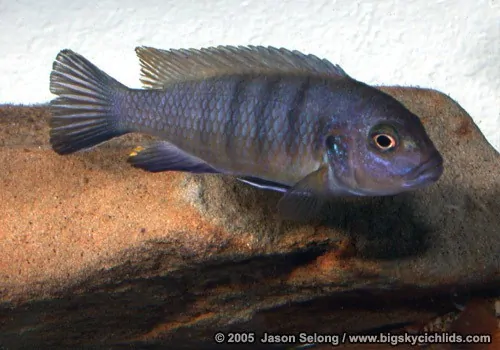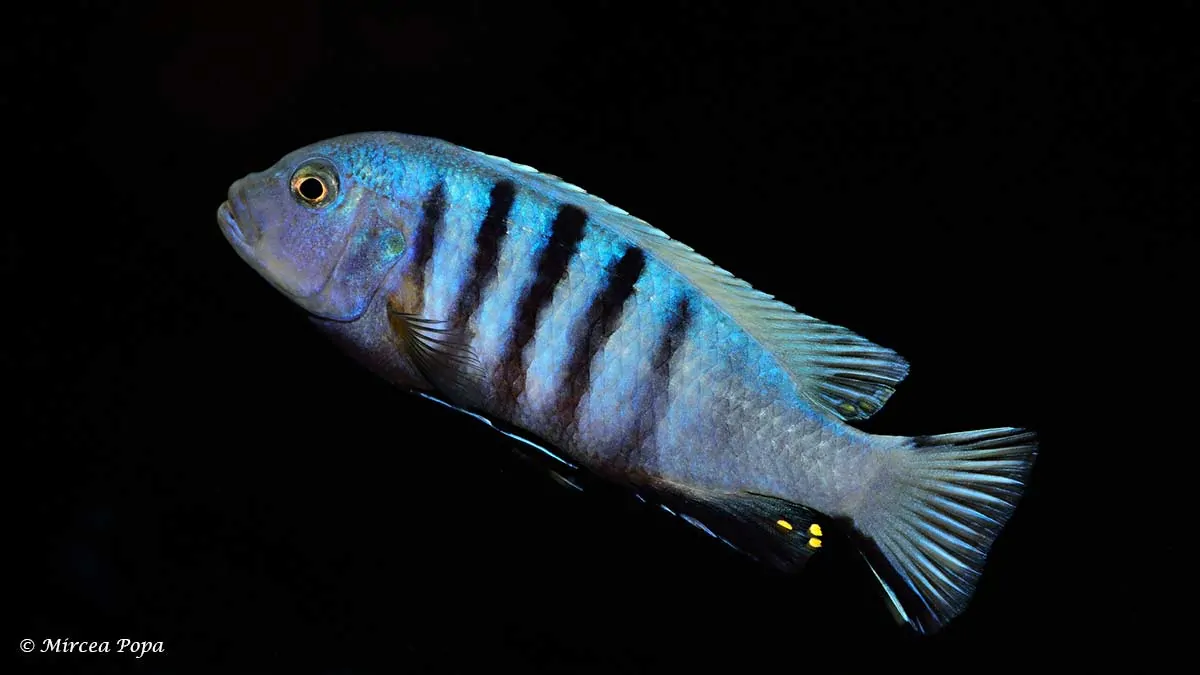Metriaclima pulpican
Metriaclima pulpican was officially described by Tawil in 2002 as Cynotilapia pulpican. The name pulpican is a reference to its behavior when defending its territory. He then harass the fish until it is driven out of the territory. The name is taken from a mythological figure from the French Brittany, korrigans, poulpicans or poulpiquets are local names for a kind of goblins.
The genus name Metriaclima is derived from two Greek words. Metri means “moderate” and clima means “oblique”. This is a reference to the sloping head.
Synonyms: Cynotilapia pulpican, Maylandia pulpican. Before they were officially described, they were referred to by a number of names, two of which are better known names Pseudotropheus sp. ‘Likoma kingsizei’ or Pseudotropheus sp. ‘kingsizei’. Also called Likoma Blue Frost in English, after the sky blue color of the males.
Description
Adult males do not grow longer than about 9 centimeters in the wild. The females stay even smaller. The abundant and more powerful food in the aquarium allows them to grow much larger. Males can even grow to a total length of 15 centimeters in the aquarium.
Once mature, males are clearly distinguishable from females. They become light blue in color with black vertical stripes on the flank. The drawing and brightness of the color may vary somewhat depending on the location of origin. The black stripes can sometimes continue into the dorsal fin. In other variants, the dorsal fin remains clear blue or is trimmed with a black stripe. The anal fin and pelvic fins are black in the male, with the edge of the pelvic fin trimmed with a light stripe. The females remain a somewhat duller brown/grey. At a later age, the female can become somewhat vaguely blue in color.
In terms of color and shape, they somewhat resemble the Cynotilapia sp. Lion and Cynotilapia axelrodi. Do not keep these species together to prevent hybridization. They also prefer the same places to form a territory that can get them in each other’s way. The axelrodi is less strong and therefore in many cases loses out.
Biotope
Metriaclima pulpican is endemic to Lake Malawi. They inhabit the intermediate zone from rocks to sand with a preference for the areas with smaller rocks. You can mainly find them at depths of 10 to 20 meters, but shallower or deeper from 4 to 30 meters also occur.
The habitat extends around Membe Point, Maingano, Mbamba, Masimbwe and Mbuzi, among others. The specimens that come from Londo and Lumbaulo in Mozambique are slightly slimmer and have smaller stripes.
The specimens that come from Londo and Lumbaulo in Mozambique are slightly slimmer and have smaller stripes. The females, young and young males without territory usually live solitary or in very small groups.
Diet
In the wild, Metriaclima pulpican feeds on the algae strands in the aufwuchs and plankton. In the aquarium it is not a picky eater and will take all the food such as flakes or granules. Just make sure that the food contains plant material such as spirulina to keep them healthy.
The Aquarium
The aquarium for a harem Metriaclima pulpican should be at least 120 centimeters (4 feet) in length. However, the colors of this species come into their own when several males have a territory and have to compete for the females. Preferably keep them in, for example, a 200 centimeter aquarium. A nice number would then be about 3 males and 6 females.
Set up the aquarium with sand on the bottom and use multiple rocks along the edges, back wall and in the center to break up the lines of sight. The males choose a territory around a burrow or near a rock where they can mate in the sand. Make sure that the rocks are firmly fixed and don’t lie directly on the glass. This species likes to dig a lot. They tend to dig away the sand around their territory.
As tank mates you can place other Mbuna that do not have the same pattern or color to prevent aggression. Despite being a fairly small species, they certainly hold their own. They fiercely defend their territory, even against the much larger Metriaclima estherae or the fairly aggressive Pseudotropheus johannii.
Plants are not necessary for this species. Soft plants will be eaten anyway. Some hard plants such as Java fern, Anubia or Vallisneria could possibly do.
Breeding Metriaclima pulpican
The breeding of Metriaclima pulpican is quite simple. The male tries to lure a female into his territory. He spreads his fins wide and with trembling movements he shows his flank to show how beautiful he is. If the female is ready to mate, she goes with him to his territory. Circling around each other, the female lays eggs in the sand. The male fertilizes the eggs while circling, after which the female picks up the eggs in her mouth. The nests of the Metriaclima pulpican are not very large. Usually the female lays about 10 to 20 eggs. After mating, the female is chased away.
The female now looks for some quieter places in the aquarium between the rocks. She holds the eggs and fry for about 21 days. The eggs hatch after a few days, but it is not until about three weeks that the female releases the fry. During brooding the female (almost) does not eat. In a mixed aquarium, only a few fry will survive if they can find enough shelter between the rocks.
Raising an entire nest
The breeder who wants to keep more young Metriaclima pulpican usually has a second aquarium where he moves the female so she can release the fry there. Use a bare aquarium with only a filter, heater and some rocks as shelter for the female. Catch the female after the second week. The female will generally hold the young while capturing. If you catch her later than two weeks, she may already spit out the young fish in the net, she usually takes the fry back in her mouth if you give her some rest in the breeding aquarium.
After about 21 days, the female releases the fry. You don’t have to worry about the fry being eaten. The female will leave the young fish alone for the first few hours after releasing the fry. After releasing the fry, put the female back in the show tank.
As a grow-up food you can give different types of food such as breeding food, dust food, but also simply crushed flake food works fine.
Video
Copyright images
Jason Selong – Bigskycichlids.com
Mircea Popa
Resources





















Reviews
There are no reviews yet.